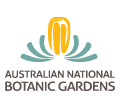 |
In Flower This WeekA weekly news-sheet prepared by a Gardens volunteerNumbers in brackets [ ] refer to garden bed 'Sections'. |
 |
In Flower This WeekA weekly news-sheet prepared by a Gardens volunteerNumbers in brackets [ ] refer to garden bed 'Sections'. |
Walking across to the Visitor Centre from the car park you can see Crowea ‘Festival’ [Section 224], a compact shrub with mauve star-shaped flowers with a white centre, also star-shaped. The flowers contrast well with the green foliage. From the Visitor Centre turn to the right down the path and just below the bubbler is Banksia ‘Birthday Candles’ [Section 174], a small shrub displaying golden candle-shaped flower spikes. Across the path is another small plant Correa pulchella (prostrate orange) [Section 174], both prostrate and orange. Further on is Woolsia pungens [Section 174], a small erect shrub with its short leaves packed tightly around the stems and lots of tiny white flowers towards the top of each stem. In the same bed further on is Crowea saligna [Section 174], a rounded shrub, again with pink star-shaped waxy flowers contrasting well with its foliage. Towards the end of this section is a group of small plants hugging the ground very well, Lechenaultia (prostrate red) [Section 174] with very dark green foliage and bright red flowers which seem to fade to orange in their centre. Scattered among the Lechenaultias are four plants of Ptilotus [Section 174] with bright yellow flowers and grey foliage, the two species look very good together.
Along past the Rainforest Gully and, on the opposite side, see Grevillea rosmarinifolia ‘Rosy Posy’ [Section 182], a group of small shrubs with dangling clusters of dainty orange flowers. At the next turn, go right and Acacia podalyriifolia [Section 126] is showing off its silver-grey foliage with golden yellow ball-shaped flowers. Correa reflexa ‘Maroondah Tricolour’ [Section 119], with flowers both pendulous and tubular, truly lives up to its name, each flower has definite stripes of red, yellow and green. Immediately behind it is Correa reflexa ‘Pink Mist’ [Section 119], with pale pink tubular flowers. On the opposite side of the path is Brachychiton rupestris, [Section 302], the Bottle Tree. The information sign in front of it is well worth reading.
Continue along this path and on the left is Thorny Saltbush, Rhagodia spinescens [Section 110]. Presently it is covered in tiny, dark red fruits, which look quite delightful against its grey foliage. If you turn left here you can see the Wollemi Pine, Wollemia nobilis [Section 110], resplendent in its large, round cage with an information sign, again well worth reading. Then wander around the Rock Garden, where there is always lots to see. Eremophila maculata [Section 15f] is covered with dark green foliage and bright red flowers while Homoranthus darwiniodes [Section 15p] has red-tinged foliage and tiny drooping yellow flowers. In the same area is Eremaea beaufortiodes [Section 15p] with huge, mauve flowers like pom-poms.
Acacia myrtifolia [Section 3] is not yet in flower but it is covered in red buds held on reddish stems again a background of green-yellow foliage. Many wattles are about to burst into flower in this area but Acacia flexifolia [Section 3], a small plant, already has lots of cheerful, small yellow balls while just behind it is Acacia linifolia [Section 3] with cream flowers accentuated by its darker foliage. The grey-green Acacia covenyi [Section 3] also looks as though it might be about to burst into flower. In the next bed is one of the prostrate wattles, Acacia dealbata ‘Kambah Carpet’, [Section 1] and though not in flower, is still an attractive ground cover.
The Eucalypt Lawn is a little further on and is a good place for children to romp, or to marvel at the variety of the barks on the gum trees, or perhaps to just sit a while. Then wander back along the Main Path and, on the way, look out for Hakea laurina [Section 20] with its narrow leaves and masses of round red flower heads with touches of white, quite spectacular at the moment.
Enjoy!
Naomi Bell
| Return to: | Australian National Botanic Gardens | Previous
'In Flower' Weeks |